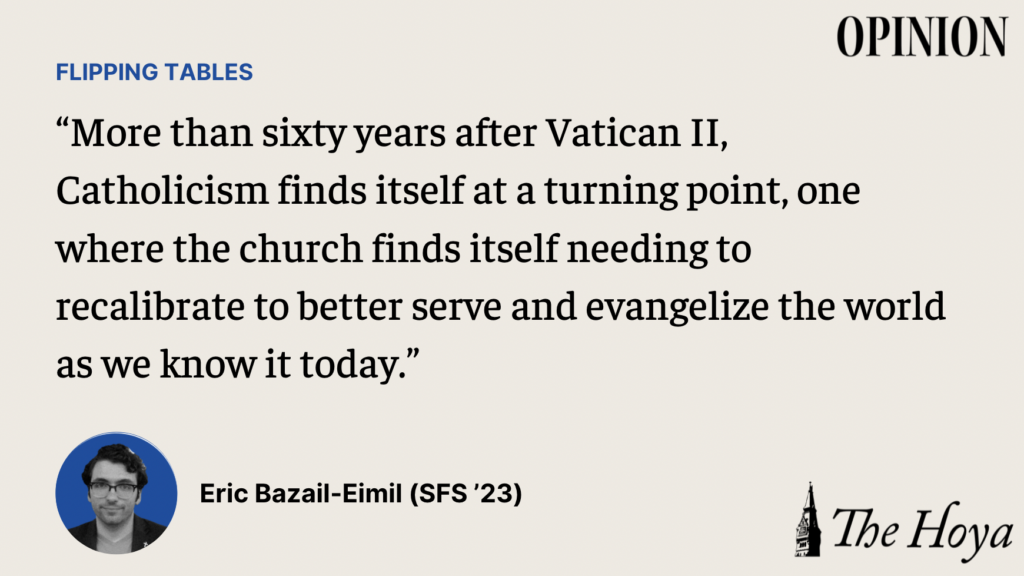At the close of the Second Vatican Council, Saint Paul VI, remarked, “never before perhaps, so much as on this occasion, has the Church felt the need to know, to draw near to, to understand, to penetrate, serve and evangelize the society in which she lives.” More than sixty years after Vatican II, Catholicism finds itself at a turning point, one where the church finds itself needing to recalibrate to better serve and evangelize the world as we know it today.
Vatican II set out to renew and modernize a church that had grown static over centuries and usher in seismic changes for Catholic worship and has undoubtedly made present-day liturgy more accessible. However, the vision of a more modern church at the heart of Vatican II, one that could adeptly adjust to the Christian world’s changing landscape, is far from universally held. Indeed, conflict between reformers and radical traditionalists who reject Vatican II’s reforms is at an all-time high as the church faces a period of decline. In the view of traditionalists, Pope Francis and the reforms his papacy has initiated in extension of Vatican II are an existential threat to the church as they know it.
Both sides are right to acknowledge the church’s decline as parishes shrink. However, Catholicism will only experience the renewal it desperately needs if we continue adapting our church in the spirit of Vatican II to better meet the demands of the present. Catholics, especially liberal ones, should demand these continued changes from both their parishes and from Vatican leadership.
Unlike what many conservatives in the church believe, easing judgment on divorce, giving communion to pro-abortion rights politicians and promoting inclusivity in the church will not destroy Catholicism. Conversely, returning to Latin Mass and the “smells and bells,” the ornate rituals that feature heavily in traditional high worship, will not once again fill the pews and engender excitement among Catholics. In reality, there are four main areas where the church is still due for growth: the way the church ministers to marginalized communities, the church’s inadequate communication of the social teaching, its theological pronouncements on major societal issues and the role of lay people in the church.
All these issues emerge from a fundamental disconnect between the church and the world it aims to serve. Indeed, when the church’s rhetoric contributes to increased suicide rates for LGBTQ+ youth, it becomes evident that the church has lost touch with modern society. Similarly, when the church struggles to communicate its progressive vision for a just society, it relinquishes its power as a force for social change. The exclusion of brilliant lay people from prominent ministerial positions in the church further bodes poorly for the church’s ability to empathetically offer pastoral and spiritual care, especially as the number of priests and nuns declines.
Looking at these challenges, my hope for the church’s future lies not in Rome, but rather in the Amazon, where progress has already begun.
In 2019, Pope Francis convened the Synod on the Amazon, one of the many decentralized councils that have defined his papacy. The Synod sought to develop solutions to the Amazonian Church’s challenges, among them the negative impacts of the climate crisis, the well-being of the Amazon’s Indigenous peoples and the decline of the church in the region as Pentecostal and evangelical Christian groups have grown in recent years.
To solve these issues, the Synod clarified theological language on climate change, outlined strict prohibitions on initiating first contact with “uncontacted” Indigenous communities and called for increased lay ministry, the possible creation of a female diaconate that would allow women to become ordained preachers and a relaxation of celibacy requirements for priests to address the region’s pronounced clerical shortage.
The Synod on the Amazon offers a window into a promising future for the Catholic Church. A church modeled off of the Amazon would embrace cultural dialogue and further empower lay people, including lay women, in ministry. The direction the Synod takes gives me hope that Christianity can live more fully in the merciful and just example Jesus set. If the church can enact continued reforms beyond Vatican II to bring itself into the 21st century, it can become a far more Christly community.
Amos 5:24 calls Christians to “Let justice roll down like waters, and righteousness like an ever-flowing stream.” I encourage my community, both at Georgetown University and across the globe, to follow suit and continue advocating for justice and righteousness.
Eric Bazail-Eimil is a junior in the School of Foreign Service. Flipping Tables is published every other week.














